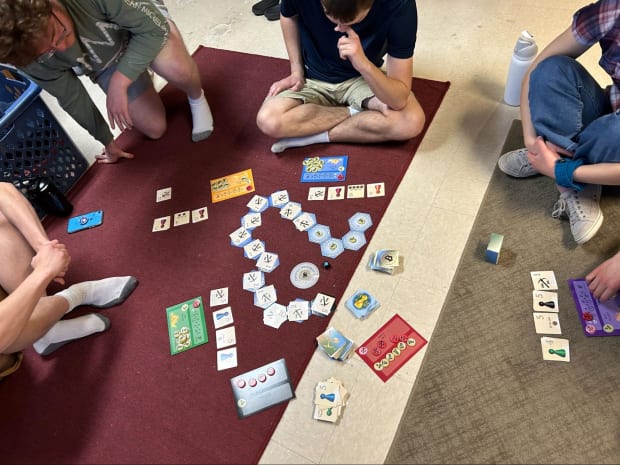The mother of a college student shares lessons from a recent orange-pilling session with her daughter and her friends at school.

This is an opinion editorial by Tali Lindberg, the mother of a college student and co-creator of the HODL UP Bitcoin game.

Hyperbitcoinization is a future that all Bitcoiners hope to witness. It is defined via the Nakamoto Institute as “a voluntary transition from an inferior currency to a superior one, and its adoption is a series of individual acts…”
But who are the individuals who must act to transition from using a given currency to using Bitcoin? I submit that today’s Gen Z college students will play a major role in that transition. Unfortunately, most of them are not following Bitcoin threads on Twitter, nor are they reading articles about the latest developments in monetary policy. Yet, they are the future leaders of our country and the world and possess the power to influence policy. It is crucial that we find a way to reach them and educate them about Bitcoin.
That’s why, as a passionate Bitcoin enthusiast, I am determined to make a difference and introduce this revolutionary freedom technology to college students. For me, making a difference means investing my time to impact, however slightly, those who have not yet joined the Bitcoin ranks. In this article, I share my experience and lessons learned with a recent example. My conclusion is we are empowered, obligated even, to make a difference in sharing Bitcoin with the young people in our lives.
Visiting My Daughter With A Bitcoin Game In Hand
I recently traveled to visit my oldest child at her college. Thankfully, she has a healthy friend group that shares traditional and respectful values. They’re good, salt-of-the-earth kids who just so happen to know nothing about Bitcoin. My perfect audience!
I arrived armed with nothing but my passion and a Bitcoin board game that I created with my husband, HODL UP. For the next two hours, I sat on a cold, hard, dorm-room floor playing the game with six students. My goal: to spark their curiosity about Bitcoin in a fun way. These students major in business, environmental science, mathematics and psychology. While they had all heard about Bitcoin through media headlines, they had no real knowledge of what it is and how it works, or even why it’s important.
Explaining the game to them was fast and easy. They had no questions about Bitcoin. They just wanted to know how to play the game. So, I spent no time explaining the parts of the game and what they meant in real life. I simply told them each player’s options at each turn. The game began and the students picked up the pace quickly.
As the game progressed, the students shared friendly smack talk as they attacked and defended their play bitcoin. The room echoed with their laughter and it warmed my heart. At the same time, however, I was itching for them, any of them, to ask me anything about what they were experiencing in the game: the difficulty adjustment, the halving, the hot and cold wallets, anything. It was hard to hold my tongue and not spoil the fun.
The game ended with a three-way tie and a close fourth place. All the students had wide beaming smiles on their faces as they high-fived each other and celebrated. Then they began to help me pack up the game pieces. As the last piece was put back in the box, I was feeling anxious that still, no one had asked me any questions. “Oh my gosh, is someone going to ask me something?” I thought. “Somebody ask me something!”
Now We’re Getting Somewhere
The students all exclaimed that the game was super fun and thanked me for sharing it.
„Great, I’m glad you enjoyed it,“ I smiled and answered, but inwardly, I shouted: “Ask me something about Bitcoin!”
Nope!
Unable to contain myself any longer, I asked them, „Does anyone have any questions about the game?“
No response.
One more try: „Does anyone understand why Bitcoin has a difficulty adjustment?“
„What?” one student responded. “That was real?“
„Yes, everything in this game has something to do with how Bitcoin works in real life,“ I answered. „What did you learn about the hot and cold wallets? What’s your best practice?“
One student answered, „Well, I learned that I should keep some money in cold but some in hot so I can make educated investments.“
“What?” I thought.
„What do you think the hot and cold wallets represent?“ I asked them.
A different student answered, „Liquid and non-liquid assets.“
“Oh, now we’re getting somewhere,” I thought. I clarified what cold storage really is and the importance of keeping their private keys offline.
Then I asked, “If you have a dollar and shoved it in your pocket, how can someone steal it without touching it?”
Without hesitation, one of the students replied, “Through money printing.”
I then explained that one of the best features of Bitcoin is that there will only ever be 21 million BTC, no more. No matter how much someone justifies needing more, there will only ever be 21 million bitcoin with a scheduled release that is managed through halving events.
It was tough not to sound preachy. I wrapped up by telling the environmental science student how Bitcoin uses wasted energy, making it productive, and forwarded a couple of articles to him. I also gave a few book recommendations to the business student who said he wanted to read up on Bitcoin over the summer.
As I was driving home, I replayed the evening in my mind and wondered if I’d made any difference at all. Then I received a text from one of the students. He thanked me for the opportunity to play HODL UP. „It was rather insightful,“ he said.
“Insightful? ‘Insightful’ is good,” I thought. “I’ll take ‘insightful.’”
“I’m just there to plant a seed,” I reminded myself. Instead of focusing on trying to orange pill someone, I’m just planting a seed. In time, life and circumstances will water the seed and, hopefully, one day the person will find themselves sliding down the Bitcoin rabbit hole. But I can’t insist on seeing the fruit of the seed as soon as I plant the seed. That feeds my ego but is the wrong focus for what I’m doing and will place an unnecessary and unhelpful strain on my interactions with students.
So, going forward, here are three things I plan to keep in mind and that I recommend to parents, grandparents and teachers in sharing Bitcoin with young adults:
- Warm up the audience and create positive association — it was infinitely easier to gain the students’ attention in discussing Bitcoin after they’ve associated a fun experience with Bitcoin than if I went in cold. Hence, the game first.
- Focus on a good time, not on teaching the nitty gritty — keep things simple and light. Explain only as necessary or if asked and avoid soap box syndrome.
- Remember, we are just planting the seed. Everyone comes to Bitcoin when they are ready. We must keep a low time preference perspective.
On to the next! Game on!
This is a guest post by Tali Lindberg. Opinions expressed are entirely their own and do not necessarily reflect those of BTC Inc or Bitcoin Magazine.

